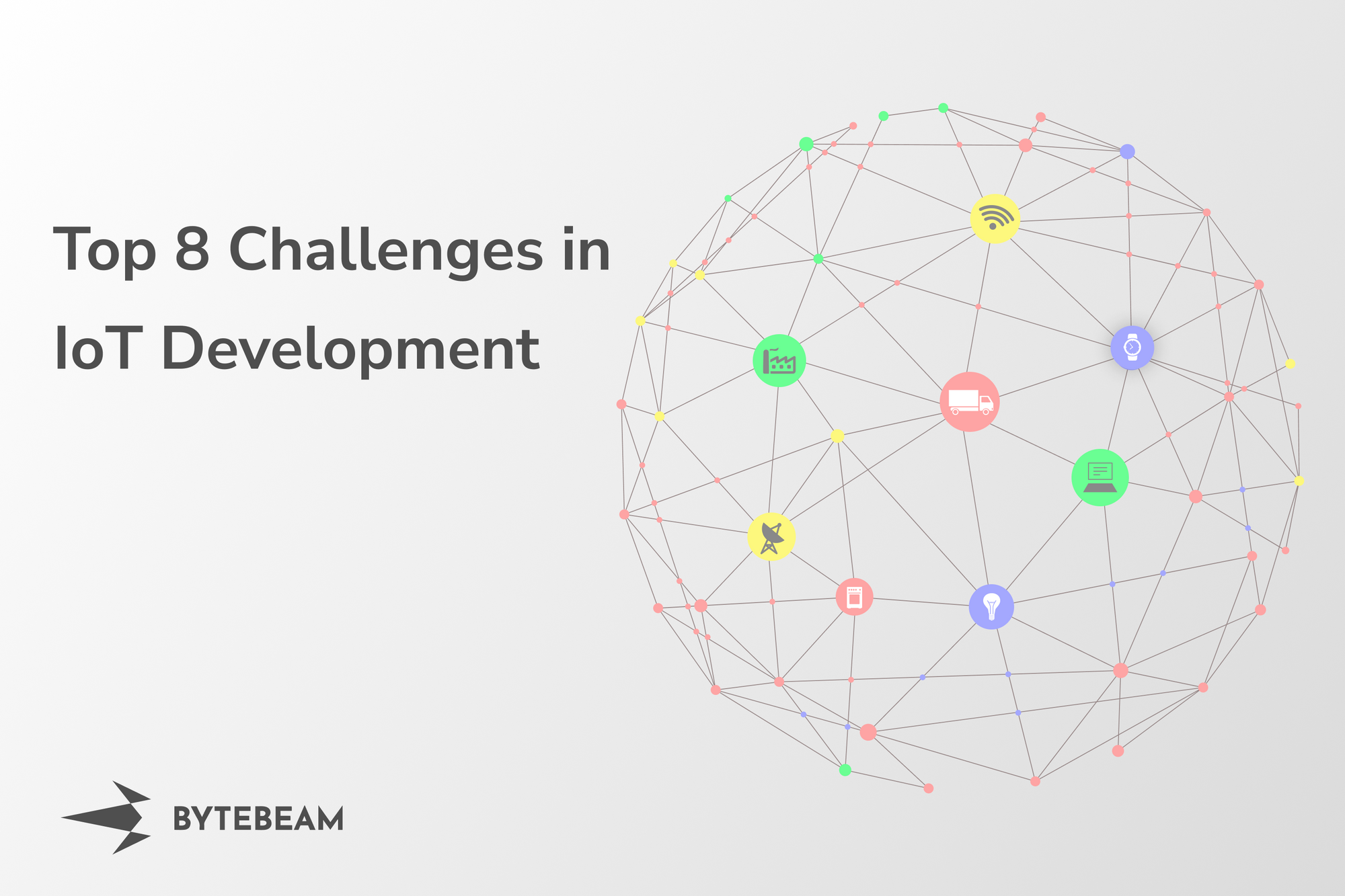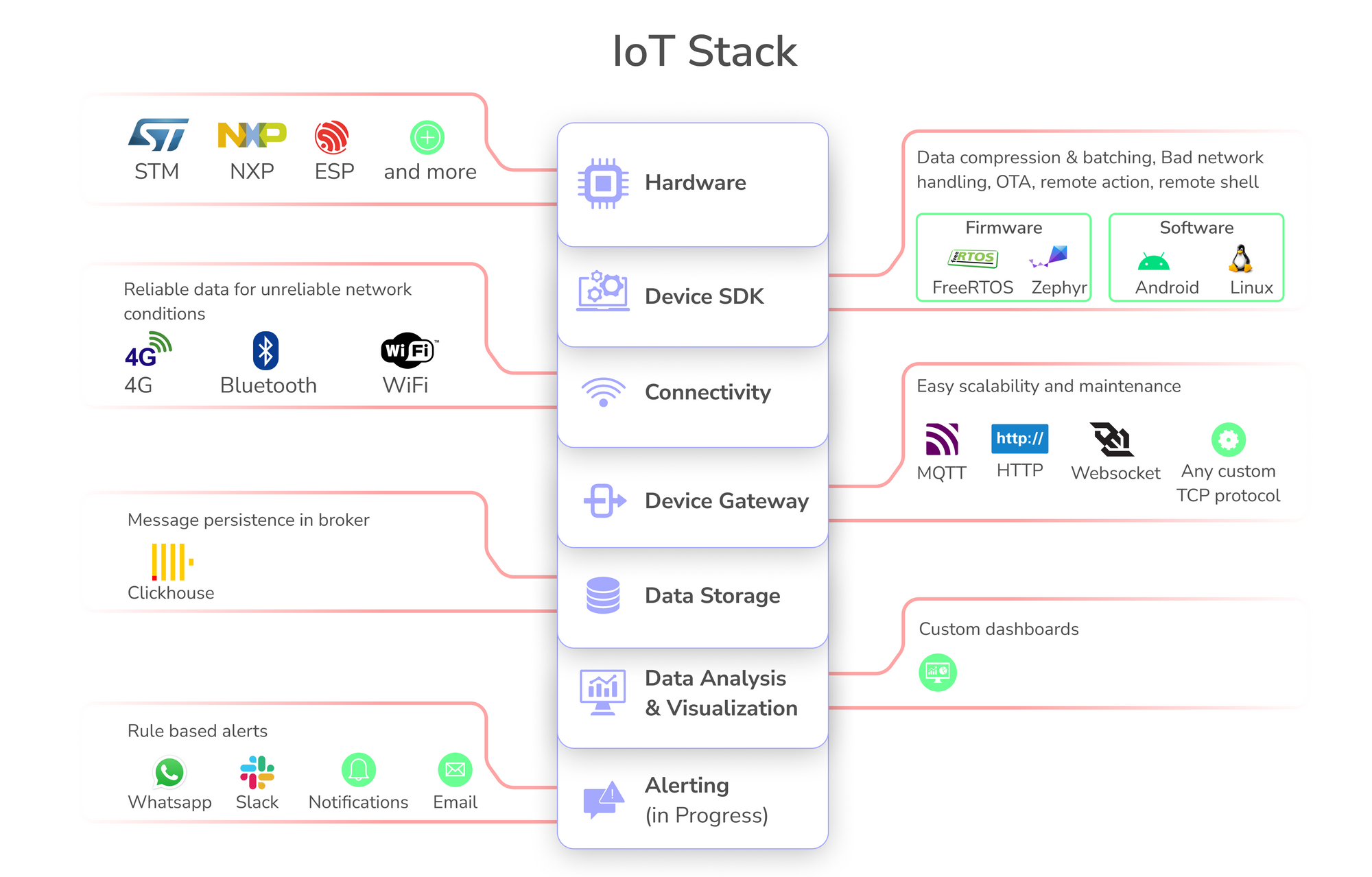Top 8 Challenges in IoT Development in 2023—and How to Overcome Them

In the United States alone, the IoT adoption rate is 94%, but what does it mean to invest in IoT? What are the challenges that come with this technology?
The Internet of Things industry stood at over USD 389 billion in 2020, and it is only expected to grow from here. Many businesses have already hopped on this technology bandwagon and there's a good reason for that. IoT investments increase revenue by saving overall costs and automating the process for any business, and this is especially true for enterprise projects.
The benefits of IoT outweigh the shortcomings However, are you aware of the challenges that come with IoT development? It is easy to simply hand over your requirements to an agency or a tech partner, but it is important to understand the obstacles to plan ahead.
In this article, we will look at the 8 most common challenges involved in building an IoT product and talk about some ways to address them.
Common Challenges in IoT Development
IoT development is intrinsically different from other development projects. It combines software programming and hardware devices, which in itself is a challenge. But IoT development also involves collection and transfer of data, and analysis. A typical IoT project has a 7-layered stack

All of this ensures that the complexities relating to IoT are multifold. Therefore, businesses need a strong plan of action to execute a successful project. Businesses usually face a number of challenges because their plan simply does not account for the complexity involved especially when they are outsourcing the project to someone else. Knowing the different ways in which your IoT project could fail will help prevent those failures. The IoT signals report has explained the same in the following illustration.

1. Security Challenges
In our opinion, security is the most crucial issue that needs to be addressed for IoT. Developers working on your IoT programming are usually not security experts, which opens your code to a range of vulnerabilities and your devices to unauthorized access.
Lack of encryption
Without encryption, the data transmitted to and from IoT devices can be intercepted and read by unauthorized parties. This is especially concerning when the devices handle sensitive or personal information.
Privacy Concerns
Users may be reluctant to adopt IoT devices if they believe their personal data is at risk. The lack of encryption exacerbates these privacy concerns, as it makes unauthorized access to personal data more likely.
Authentication Issues
Encryption is often used in conjunction with authentication protocols to ensure that the device communicating on the network is actually the device it claims to be. Without encryption, these authentication protocols are less secure, making the network more vulnerable to attacks.
Network Security
Unsecured IoT devices can be exploited as entry points into a network, putting not only the device but also other devices on the network at risk.
Access Management
Developers sometimes include backdoor access in devices to allow for easier troubleshooting, debugging, and updating of the software. A backdoor is essentially a hidden entry point into the device that bypasses the normal authentication mechanisms. While this can be convenient for development purposes, leaving such a backdoor open in production devices poses significant risks.
To ensure IoT security you need to engage with a security expert and make sure the communication stack between the device and the cloud as well as the backend stack is regularly tested for vulnerabilities.
As IoT brings together several technological elements such as hardware, software, data transfer and storage, network connectivity, and more, there are several areas that can be exploited to gain unauthorized access.
2. Costs
The infrastructure that IoT requires is expensive in itself, but the overall costs often prove to be a surprise for most people. There are invisible costs to every major undertaking, and IoT projects are not an exception to this. The cost of updates, maintenance, design, replacing outdated devices, and the technical skillsets required can pile up very quickly.
The costs of IoT development are high because the infrastructure has not caught up with the technology yet, and finding the right team with the required expertise is very difficult. However, this is quickly changing as more businesses invest in IoT.
3. Reliability and Hardware
As we have discussed previously, any successful IoT undertaking requires a robust and secure infrastructure. Depending on the industry and business, the physical devices may vary but their quality, upkeep, reliability, and efficiency are extremely important.
Let’s take sensors, for example. Many people believe that cheap sensors are easily available and effective. However, sensors that last long and are reliable are rarely inexpensive. If the upkeep of sensors used for delicate operations, such as gas or pH sensors, is not regular and thorough, the data received from these can be unreliable.
The overall hardware requirements are not always aligned with the available resources, and it needs to be considered before the project is started.
4. Ease of Integration
One of the most complex parts of IoT development is ensuring that the IoT application can be integrated with various platforms, OS, cloud services, and even legacy systems. The failure to do so can result in a low-usability product that may not survive the advancements in technology and business practices.
5. Connectivity
IoT sensors can only collect and transfer data if the connectivity is strong, and that is not always the case. Especially when the devices are placed in remote areas, connectivity can become a real issue. When you’re required to connect multiple cloud servers, physical devices, and applications, connectivity is very important for the success of your project.
Local connectivity is equally important for IoT devices. For example, if your devices are Bluetooth connected, they will not perform well over long-range connections.
6. Development Skillset
Finding people who are experts in IoT and also understand security, hardware, and user requirements is extremely tough. This is a multi-domain expertise that also comes with further specialization in industry and scale.
As the size of the IoT industry grows, the demand for IoT professionals has shot up, which is not at par with the supply. This usually means that the cost of the project goes up, and you might not have people with the right skillset to execute your project.
7. Quality Control
Along with skilled professionals, the demand for hardware has also increased. In a bid to keep up with this demand, manufacturers often rush the process which results in lack of testing and updates. Devices that are not thoroughly tested can be a security threat, and often end up being unreliable.
This also poses a problem with automating device management. Many businesses struggle to automate updates and these devices can only be updated with physical access. This increases the overheads and causes bottlenecks in the process, while also being a security issue.
8. Design
As IoT becomes commonplace across the world, usability becomes a key concern. The interface that allows you to handle multiple devices at the same time has to be as well designed as the overall system. If the user experience is not taken into account, the efficiency of your devices and processing will make little difference.
Usability involves more than just the UI though. User problems like battery life, and connectivity are just as important to the overall user experience. These issues can end up creating a poor product that will not be very helpful to end-users.
How to overcome these challenges?
Having considered these challenges, it is important to understand that planning ahead and management of resources can help you overcome almost any challenges that you may come across. What’s more? IoT is absolutely worth the trouble! A well-developed IoT application can help you create additional revenue streams, lower your costs and also help you build sustainable processes.
We have built a primary checklist to help you overcome the most common challenges associated with IoT development:
- Vet the technology partners you outsource your work to. Look for: team members with expertise across the stack, a strong portfolio, automation capabilities, device management, and technical know-how.
- Budget for security solutions. You may need to add security solutions or additional security experts to the team depending on your requirements.
- Research the quality, durability, and reliability of the devices you invest in. While there are a lot of cheap alternatives available, they may end up costing you more in the long run.
- If you are building an in-house team, budget for the skillsets required. Investing in people will help you go a long way.
- Ensure that the updates and maintenance are frequent and regular.
- User research is non-negotiable. It will help you build a strong user experience and give you a better understanding of their requirements.
This list is not exhaustive by any means, but it will help you get started on the planning and budgeting of the project. If you are already mid-project, it can help you refocus your priorities.
It is always better to understand all aspects of a project before diving in. Given that IoT is a high-reward undertaking, the prep work is also extensive. Do you have any more questions about IoT development and its challenges? Feel free to reach out to us for more information.

